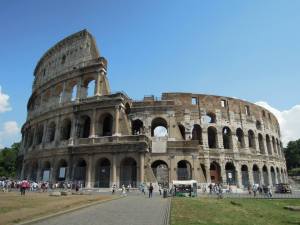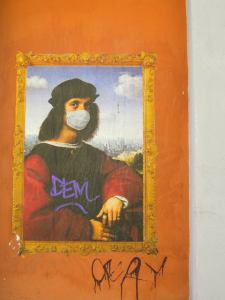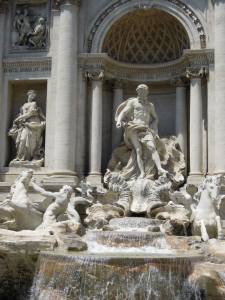As historical cities go, Rome has to be considered as one of the greatest. The centre of an ancient empire that ruled most of Europe and stretched into western Asia and northern Africa. I was good at history at school (A at G.C.S.E.!), but I would definitely say my interest in history was only briefly temporary. As I have matured (cough*), I think I am much more a person interested in the ‘now’ rather than the past. My trip to Rome therefore was one that I was feeling uncertain of. I definitely wanted to go, I had an idea of what I would be presented with, I just wasn’t sure what I would make of it all…
Another swift train journey done and I had arrived in Rome. The train station was quite aged and busy. I tried to look up train times for my next destination in a few days, Pisa, but a persistent and unfriendly beggar motivated me to seek out my hostel instead. I was disappointed with the subway as well. Grotty! Anyway, enough of my public transport reviews. I got to my hostel and upon finding I was sharing a room with a creepy old man and two other yet to be filled beds, I decided to make a hasty exit to the streets of Rome. My first stop was the Colosseum. I braved the subway again and headed out into the slightly stuffy and humid Roman air. The Colosseum is an amazing sight, I found myself at the subway stop several times during my stay in Rome and each time I was easily distracted by its incredible and ancient presence. I didn’t pay to go inside, it seemed a lot just to look at the brick ruins inside when I could look at them from the outside for free. From the Colosseum I decided to walk to an area called Trastevere. On the way I passed more of the city’s open air museum sights, I walked through a Roman ippodromo and past towering columns, ruins and bridges.
Trastevere is on the southern bank of the river Tiber, outside the boundaries of the ancient city, and belonged to the hostile Etruscans. That is of course until Rome inevitably conquered it. Since then it has had a multifunctional history, a home for fishermen and sailors, a Jewish settlement in the middle ages and the home of one of Julius Caesar’s villas. It has been a mish-mash of rich and poor, Roman and non-Roman over the years and this is reflected in its maze of winding cobbled streets that stand across from the Tiber and rise up the Gianicolo hill. It is a popular area with tourists, artists and has been the inspirational home of musicians and film directors. I really enjoyed walking the streets, eating a little lunch in a small cafe and dipping my head inside some of the small art galleries and churches. When I came back the following day in the evening the streets bustled with natives and tourists, music and chatter filled the air and people spilled out onto the cobbled avenues with their beers and paper aperitivo plates in hand.
From the streets of Trastevere I climbed Giancolo hill. At the summit of the steep stepped passageway I was greeted by the very grand Fontana dell’Acqua Paola. I traversed the hill above the park that lay below and was able to enjoy the wonderful vistas of Rome. A prime viewing point is presented in the shadow of a pompous bronze statue of the famous Italian hero Giuseppe Garibaldi. Domes, churches and bell towers pierced the sky across the city, and you can really appreciate the grandness of ancient Rome due to the lack of highrise modern development. In contrast a squadron of mod-style scooter enthusiasts were continually buzzing around the roundabout at the top of the hill and admiring their shiny bikes.
My rambling continued and the next Roman sight I stumbled into was the Vatican. A continuing theme of my summer travels was repeatedly becoming European landmark restoration. Of course, large parts of the exterior of the Vatican were covered with scaffolding but it was none-the-less an impressive sight. The Vatican was actually quite cheap to visit but unfortunately I had arrived around dusk and the entrance was closed. I planned to come back the next day but never made it and thus I missed out on seeing the frescoed interior of the Sistine Chapel.
I began the long trek home after having dinner at Piazza Navona, a very vibrant city square with street entertainers and lots of bars and restaurants. I walked back to the Colosseum via numerous detours. I had lost my map and was in need of a landmark. I headed for the river Tiber and followed it back to the ippodromo and the Colosseum. The Colosseum was lit up beautifully, although I doubt they would have had powerful spotlights back in Roman times to achieve the same effect. I got the subway back to the hostel and was heartily relieved that the two other beds were occupied and I wouldn’t be alone with the weird old man.
My second day in Rome started with a well deserved sleep-in. I managed to make the last call for breakfast and headed out. My first stop was the train station to sort out a ticket for the following day. I wanted to get a cheap ticket I had seen advertised before it sold out. I managed to get the ticket without being harassed by a homeless man, but I was briefly distracted by a comical, if not slightly painful looking, pile-up on the escalator. It was all very Mr Beanesque as some girls luggage got trapped at the top and everyone behind fell over each other. Even the security guards trying to help made it worse.
If i thought I walked a lot the previous day, my second day in Rome would eclipse that belief. It will be simpler to list the highlights:
1. The Wedding Cake
In a continuing horizon of terracotta roofs and ancient ruins “The Wedding Cake” stands out like a sore thumb. Altare della Patria is an outlandish, chunky and white monument to Victor Emmanuel the first king of unified Italy. Although it has great cultural significance it is considered a bit of an eyesore considering ts ancient surroundings.
2. The Pantheon
The outside of the Pantheon is quite deceptive. The majority of the building is round in shape with high, undecorated stone walls. A typically Roman columned entrance with a triangular roof sits at the front of the building and looks almost out-of-place against the simple curved wall behind. Inside however is a different proposition. Not only does the domed interior feel five times bigger than it appears outside, but a powerful ray of light pierces the dullness inside from a circular hole in the roof. Whilst ancient Rome generally lies in ruins around the city the Pantheon has held firm over time. Inside huge archways house icons of the church and if you time your visit correctly you can get a dramatic photo as the beam from the oculus above lights up an archway. By modern standards you would consider the Pantheon breathtaking and I think it was undoubtedly my favourite sight in Rome.
3. The Trevi Fountain
If the Pantheon was my greatest attraction in Rome the Trevi Fountain was my biggest disappointment. The fountain was quite appealing but a lot smaller than I had anticipated, more so it was also an area that was packed with tourists. getting a good view was nigh on impossible. Still, it was another box ticked.
4. Villa Borghese Gardens
The previous day I climbed the ridge above Trastevere, on my second day I went across the valley and climbed the Spanish Steps and worked my around to another ridge to the Villa Borghese Gardens. If you want to escape the streets and the crowds in Rome then this is the place to go. The second biggest park in Rome is full of trees to shade from the sun, open grass areas to worship the sun and small ponds to cool your feet. I spent most of my time relaxing with my book and wondering about Rome’s obsession with building a statue of every famous and semi-famous person from history (Imagine if we still had that attitude now? We would have statues of the most inane people littering the streets of London. Whilst Rome is full of kings, explorers and artists. London would be full of pop-singers, reality TV stars and footballers. A statue of Rick Waller, Jordan and Wayne Rooney anyone?) but the park has some great villas to admire, as well as a rather spooky and half-abandoned underground chopping centre. This was all of course, if you could avoid tripping over amorous couples who littered the grounds of the gardens like dangerous land mines.
I stayed out late and walked back to Trastevere for an aperitivo and met a couple of cool French guys and had a few beers before heading back. The next day I would check out early and head on the slow but cheap train to Pisa. I left Rome satisfied, it had definitely exceeded my expectations and I even feel that I would go back. I’m not sure that two days really does it justice.





















